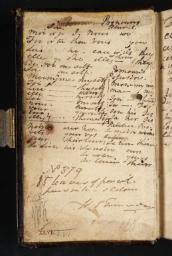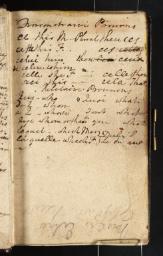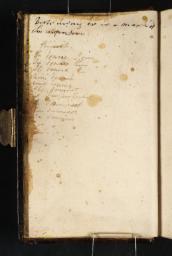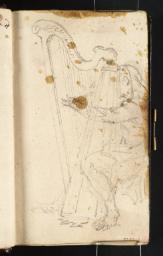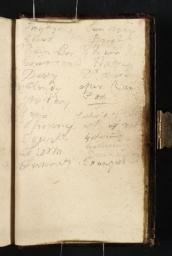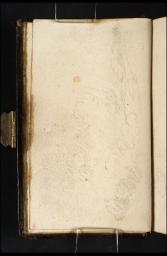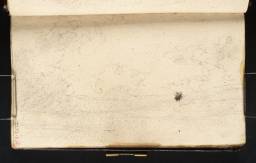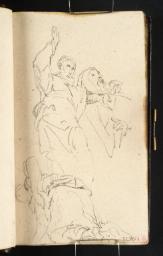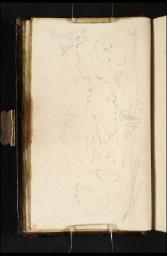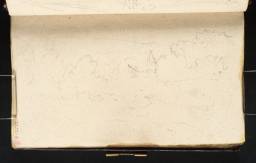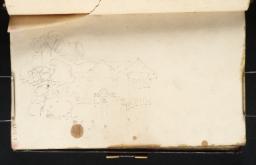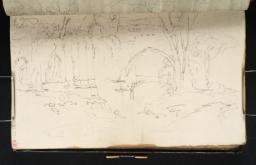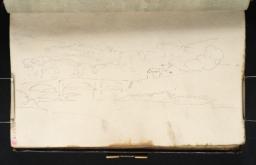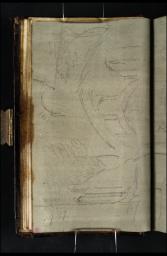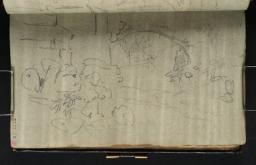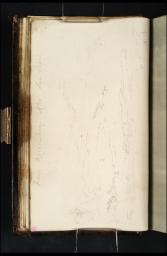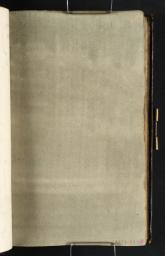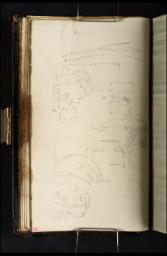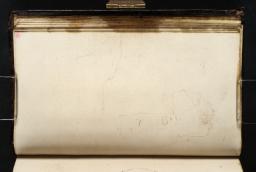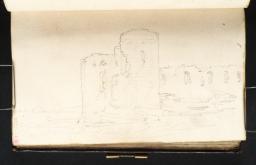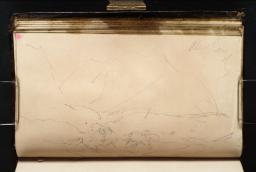Turner Bequest XLVI 1–120a
Sketchbook bound in boards covered in calf leather with gold tooled edge and spine; one brass clasp
120 leaves of white wove paper, 130 x 79 mm; watermark ‘J Whatman 1794’
Inscribed by Turner in ink ‘38 Studi[?es. Col.]’ on vellum label on spine (D40765)
Numbered 379 as part of the Turner Schedule in 1854, and endorsed by the Executors of the Turner Bequest inside front cover (D40766)
120 leaves of white wove paper, 130 x 79 mm; watermark ‘J Whatman 1794’
Inscribed by Turner in ink ‘38 Studi[?es. Col.]’ on vellum label on spine (D40765)
Numbered 379 as part of the Turner Schedule in 1854, and endorsed by the Executors of the Turner Bequest inside front cover (D40766)
Accepted by the nation as part of the Turner Bequest 1856
Exhibition history
References
Turner took this small sketchbook with him on his tour to the north-west of England and Snowdonia in the summer of 1799, using it in alternation with his Lancashire and North Wales book (Tate; Turner Bequest XLV). His equipment for that journey was amplified by the portfolio of large sheets that he used to make watercolour studies on the spot, also addressed in this section of the catalogue. It is interesting that at least one of the subjects treated on that large scale was sketched in the miniature format of this book; see folio 19 verso (D02023). He seems to have regarded it not simply as a place in which to jot down views encountered on his journey, but also as a repository of ideas for pictures arising from those encounters, or from other circumstances altogether.
Although there are some blank leaves, this is one of the most densely packed of the books of these years in terms of the range of subject matter. In this respect it has similarities with the Wilson sketchbook of a year or two earlier (Tate; Turner Bequest XXXVII), which contains studies from paintings by other artists, and elaborate technical exercises exploring effects of light and shade. Other books in this mould are the Studies for Pictures book, perhaps begun in this year and in use over the turn of the century (Tate; Turner Bequest LXIX) and the rather later Studies for Pictures: Isleworth book of about 1804–7 (Tate; Turner Bequest XC). The fact that Turner labelled the Dolbadarn book ‘Studies’ is an indication of his sense that it belonged to a different category of book from those he used primarily for topographical recording.
This sense that the sketchbook is dedicated to technical and compositional experiment no doubt explains Turner’s careful washing of so many of its pages with coloured grounds; though as is often the case with such reparations they are not always utilised in practice. Consecutive leaves are not necessarily washed similarly, so that drawings on double-page spreads may be partially on one ground, partially on another, or, more usually, on unwashed paper. A number of leaves here are clearly one or more stages removed from the topographical motif. On folios 114 verso and 118 recto (D02165, D02172) there are two copies after paintings by Nicolas Poussin (1594–1665), which show that Turner had the book in his pocket in London, where those pictures were exhibited. Also towards the back are several notes of ideas for figure subjects and marines: the expanding range of his interests at the end of the decade is well encapsulated here.
Several marines and historical subjects were in gestation at this time, as well as the large watercolour of Caernarvon Castle, North Wales, exhibited at the Royal Academy in 1800 (Tate D04164; Turner Bequest LXX M),1 and its never-completed pair, The Destruction of the Bards (Tate D04168; Turner Bequest LXX Q) – a ‘War and Peace’ coupling that involved much of his experience of North Wales both as a geographical area and as the setting of medieval historical (or quasi-historical) events. The sequence of large watercolour views of Fonthill Abbey that Turner had been commissioned to make for William Beckford also figure in this book: there is a group of slight but significant composition studies for them on folios 106 verso, 107 recto, 111 recto and 113 recto (D02152, D02153, D02158, D02162).
Some pages in the book are devoted to drawings of Whalley Abbey and its neighbourhood, which Turner visited at the behest of Dr Thomas Dunham Whitaker, of the Holme in Cliviger, near Burnley, to execute illustrations for Whitaker’s planned History of the Original Parish of Whalley and Honour of Clitheroe, published in 1800–1. The bulk of Turner’s drawings for this project are in the contemporary Lancashire and North Wales book (Tate; Turner Bequest XLV). In general, the drawings follow no clear sequence, but are made at random, so that it is not always possible to identify a subject on the basis of neighbouring drawings. This is a procedure similar to that followed in other small books, notably the Dynevor Castle sketchbook, used on the 1798 tour to Wales (Tate; Turner Bequest XL).
Technical notes
How to cite
Andrew Wilton, ‘Dolbadarn sketchbook 1799–1800’, sketchbook, May 2013, in David Blayney Brown (ed.), J.M.W. Turner: Sketchbooks, Drawings and Watercolours, Tate Research Publication, April 2016, https://www

